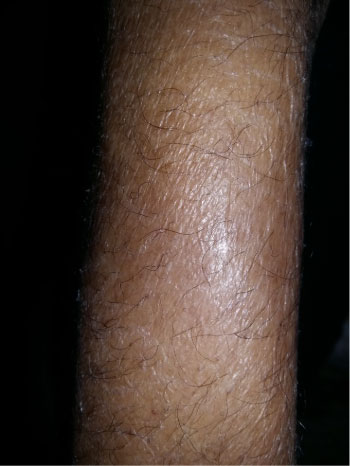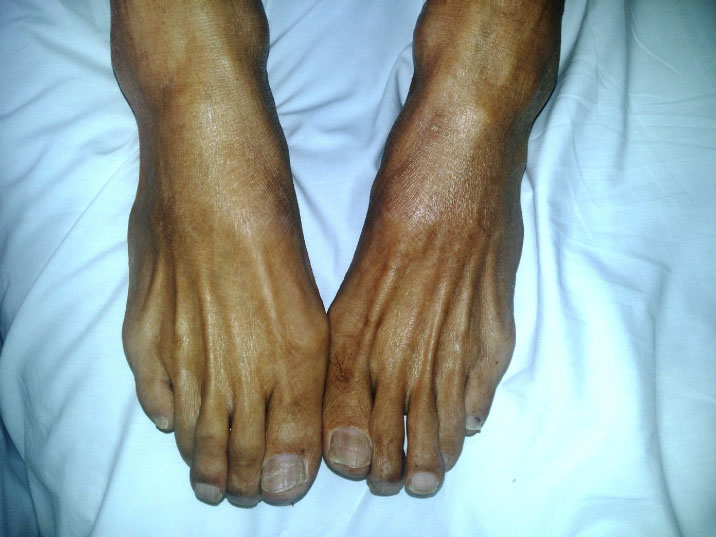Dermatological manifestations are frequent and varied among chronic hemodialysis patients. The aim of this study is to determine the prevalence and characteristics of cutaneous abnormalities observed in hemodialysis patients.
We led a transversal study, conducted at the Nephrology Department of the 5th Military Hospital in Guelmim, from March to May 2017, including 44 hemodialysis patients.
The mean duration of hemodialysis was 61.81 months. Causes of end stage renal failure were diabetes (45.45%), high blood pressure (13.63%), lithiasis (4.54%), gout (4.54%), reflux nephropathy (4.54%), glomerulonephritis (4.54%), and indeterminate (22.72%). All our patients had dermatological abnormalities. Pruritus (63.63% of patients), Cutaneous xerosis (40.9%), hair loss (36.36%), and hyperpigmentation (22.72%) were the most common skin manifestations. 68.16% of our patients had nail disorders.
The knowledge of these manifestations allows a proper care, so to improve the quality of life of the hemodialysis patient.
Chronic renal failure, Cutaneous manifestations, Hemodialysis
Hemodialysis is an extrarenal procedure to correct the dysfunction of the exocrine functions of the kidney, which has significantly improved the quality of life of End-stage renal disease patients. Nevertheless, these patients have some cutaneous abnormalities that are frequent and varied.
The aim of this study is to determine the prevalence and characteristics of cutaneous manifestations observed in hemodialysis patients.
This descriptive transversal study was conducted at the Nephrology Department of the 5th Military Hospital in Guelmim, Morocco, collecting all hemodialysis patients who had been on chronic dialysis for at least 3 months, 3 times a week.
The dialysis method was conventional periodic dialysis. The membrane was made of polysulfone and the sterilization of the consumable was done by steam. The study was conducted over a period of 2 months, from March 20 to May 22, 2017. All patients were examined.
The collected data including sex, age, antecedents, hemodialysis history, dermatological signs, and their occurrence circumstance, their evolution, the treatments used.
Data analysis was performed with SPSS software. Quantitative variables were expressed on average and qualitative variables in percent.
Our study included 44 chronic hemodialysis patients undergoing regular dialysis three times a week. 24 patients were males and 20 were females, their mean age was 55.36 ± 15.82 years and the median duration of dialysis was 61.81 months. Causes of end stage renal disease were diabetes (45.45%), hypertension (13.63%), lithiasis (4.54%), gout (4.54%), reflux nephropathy (4.54%), glomerulonephritis (4.54%) and unknown (22.72%). 20 (45.45%) patients were diabetic, 6 (13.63%) had ischemic cardiopathy and 4 (9.09%) had peripheral arterial occlusive disease. The patients' body mass index ranged from 17 to 31.40 kg/m2 (mean 23.07 ± 4.50 kg/m2). All characteristics of patients are shown in Table 1.
Table 1: Characteristics of patients included in the study. View Table 1
All our patients had patients had cutaneous manifestations related to their chronic renal failure or dialysis.
Pruritus was reported by 28 patients (63.63%), It was localized in 12 cases (42.8%). Pruritus was nocturnal increasing in 14 patients (50%), and continuous in 10 patients (35.71%). Cutaneous signs accompanying Pruritus were skin xerosis in 13 patients (46.42%), linear streaks in 7 patients (25%) and lichenification in 3 patients (10.71%).
Cutaneous xerosis was observed in 18 patients (40.9%). It was diffuse in 33.33% of cases, and localized in 66.66% of cases (Figure 1).
 Figure 1: Cutaneous xerosis. View Figure 1
Figure 1: Cutaneous xerosis. View Figure 1
Hyperpigmentation was the most pigmented abnormality observed, in 10 patients (22.72%). Hair loss was observed in 16 patients (36.36%) (Figure 2).
 Figure 2: Hair loss. View Figure 2
Figure 2: Hair loss. View Figure 2
Nails disorders were found in 30 patients (68.16%) such as onychodystrophy in 12 cases (40%), pachyonychia in 6 cases (20%), xanthonychia in 4 cases (13.33%), melanonychia in 4 cases (13.33%), digital clubbing in 2 cases (6.66%) and koilonychia in 2 cases (6.66%) (Figure 3).
 Figure 3: Onychodystrophy. View Figure 3
Figure 3: Onychodystrophy. View Figure 3
Other cutaneous signs observed in our study are shown in Table 2.
Table 2: Distribution of patients according to different cutaneous manifestations. View Table 2
Cutaneous manifestations in hemodialysis patients are polymorphous, their frequency was high in our study, and the incidence of cutaneous manifestations varies from 50 to 100% in different studies [1].
Pruritus is the most common symptom in chronic hemodialysis patients. In our study, the incidence of pruritus was 63.63%. Its frequency was estimated between 70 and 90% in others series [2].
Atrophy of the sebaceous glands associated with a decrease in the surface of the lipid film in chronic hemodialysis patients leads to dehydration of the stratum corneum. These changes promote pruritus [3].
Cutaneous xerosis is a common complication in hemodialysis patients. It can be seen in chronic renal disease before hemodialysis, but a significant increase in its frequency is observed after the start of dialysis. It disappears after renal transplantation. The frequency of cutaneous xerosis varies between 28% and 80.5% in different studies [4].
Hyperpigmentation were common: 22.72% of patients, joining data from other series ranging from 17 to 70% [5], and its pathogenesis is linked to the accumulation of melanostimulin by renal excretion defect and through the dialysis membrane [6].
Nail diseases are frequent in hemodialysis patients, 68.16% of our patients had nail abnormalities, which is similar to the rates reported in the literature (60 to 66%) [6].
The pathogenesis of nail disorders remains unclear: some of them may be directly related to renal disease; others seem to be related to his complications or to different therapies received [7].
Diffuse hair loss, dry and fragile hair, is observed in chronic haemodialysis patients, with frequencies ranging from 20 to 25% in the literature; which is lower compared to our study (36.36%). The dryness of the hair is due to a reduction in the production of sebum and hair loss is probably multifactorial [8].
Our study contributes to a better knowledge of the cutaneous manifestations in the subject haemodialysis in developing countries because of insufficient data reported in the literature on this topic [9].
The knowledge of these manifestations allows a correct care and a better collaboration between dermatologists and nephrologists, to improve the quality of life of the haemodialysis patients.
The authors declare no competing interest.
All the authors have read and agreed to the final manuscript.